The ask is $50 billion dollars for a SCUHVDC electric transmission pipeline
Renewable energy building, soil saving, electric boat consulting, heat pump promoting, guy who is trying to save the bees, Kelvin Hodges, wants your money. Here’s why
The 2023 GreenDAVID initiative starts now

In Canada we’ve built national railways, national highways, national pipelines, even a national hiking trail, we built them to make Canada stronger, richer, a nation. The future is here, its time to build a national energy backbone.
Our new backbone will be the carrier of electricity from every province and region and to every province and region. It will save every Canadian money every year on energy costs. It will create a resource that we can export to the world.
The technology is SCUHVDC
Step 1
Canada’s electricity backbone is built on the advances in UHVDC! That many letters you know its good. It stands for Ultra High Voltage Direct Current. And if we could build it in SC for super conducting, or SCUHVDC. Whew. That would be a good thing.
This SCUHVDC backbone means every part of Canada can share electricity cheaply and easily with every other part of Canada.

What about cost?
- Canada’s 8,000 kilometer electric backbone will cost between 12 and 16 billion and stretch from coast to coast with multiple side branches.
- 5 billion for a UHVDC cable factory, training and what ever else we can think of. We have the materials. Might as well make our own cable and sell the products we produce to the world.
- 3 billion for super conducting ultra high voltage electrical transmission research. This should position Canada as a world leader in this field.
A project of this size and scope should create many opportunities for Canadian companies exporting to the world.

Okay. Now we have our backbone built, let’s plug in the power!


Let me just point out:
- The map to the left is solar insolation. The dark orange area at the bottom of the prairie provinces is the second highest solar insolation value you can have. Canada’s key advantages: this is a huge area of land that is also cold. What does long term efficient solar love; not being hot. Cold is a good thing.
- The map to the right is mean wind speed. Here we clearly see that Canada is a wind speed super power. Those dark red spots: these are the best wind values on the planet. Remember, we only need 750 of the new 15Mw wind turbines to power every home in the Canada. Read on for more.
Plug in the power
Step 2
Well this is kind of a no brainer to start. Plug in BC, Manitoba, Quebec hydro and Ontario nuclear. Each province already has resources paid for and ready to plug in. Poof, instant renewable or repurposed energy source. Nice. Cost to tie in should be pretty reasonable. A billion or two to keep things moving?
Build wind
The east coast of Canada is one of the best wind resources in the world. Each new 15mw wind turbine runs 15,100 Canadian homes. Because of our fancy SCUHVDC backbone; those homes can be anywhere that is attached to the line. Hah ha! And we need only build 999 turbines to run every one of our 15 million homes. Heck, as its always windy somewhere, we can build these turbines all over Canada. Every province is blessed with many “world’s best” wind sites.
That’s a mere 12 billion. Although, we don’t need 999 turbines because we have other new renewables coming.
Build solar in southern Manitoba, Saskatchewan and Alberta
Agrivoltaics, the use of fields of solar panels to also produce farm crops, in this amazing area for solar; lots of sun hours plus colder temperatures; this is a win-win-win. That super cheap easy to build sunshine power can go anywhere thanks to our backbone. Land required is around 500,000 acres and let’s budget 5 billion. Lots of solar panels and racking. Plus, lets fund cool jobs in agriculture research.
Put solar and batteries into homes
Put solar on every roof suitable in Canada. Home solar now comes with home storage. This is exceptionally cost effective, the payback can be 3-5 years if you’re adding in electric appliance change over as well (that’s cars, heat pumps, lawn mowers). The recent advances in home solar, not to mention home appliances, has been much overlooked. Though, on heat pumps and EVs, perhaps everyone has got the message. Now we need to add home batteries and solar to manage grid overhead costs.
This comes with a big training ask. We need, in all likelihood, 50-100,000 workers here. I know many groups willing to help (unions, colleges) so 3 billion in rebate incentives and 2 billion in training funds?
Step 3: Carry further on
Carbon reduction and capture: 5 billion
Reducing carbon production saves homeowners money
GreenDAVID has also been active in promoting and helping install heat pump technology for home use. Heat Pumps are suitable across a wide range of Canadian climate zones. May we suggest, for Canada, basic standards are: good to -30 with an HSPF of 12 or better.
A conversion to all electric appliances; Cars, home heating and cooling, toys, etc. means lower cost energy reduces overhead for Canadian lifestyle choices. Both financially and environmentally, this conversion makes sense.
Solar power powers these CO2 reduction technologies. See our solar sales experiment BobolinkSolar to take a quick peek at where we’re at after 6 years of testing problem solutions.

Recapturing carbon saves farmers money
Then we recapture CO2; At GreenDAVID we believe there are many ways to store or capture CO2. As we are Canadian with large farm, lawn and garden areas, we are looking at three methods. These are no-till farming; cover cropping; and exogenous organic matter (EOM) — significant research is finding that bringing organic waste materials from elsewhere to apply to soil rebuilding in farm and garden soils has real potential to save fertilizer overhead costs and sequester carbon.

One project we have been running is the use of fungal dominant compost (FDC) as an EOM to rebuild lawn, garden and farm soil. You can learn more about this project by checking out ONfungi.
Thank you.
Membership GreenDavid
Join the club… membership supports staffing, supplies, research and more …
Contribute with your voice


Leave a Reply